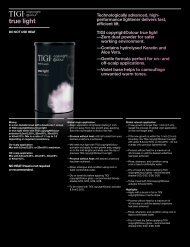For The Love Of Colour - TiGi
For The Love Of Colour - TiGi
For The Love Of Colour - TiGi
Create successful ePaper yourself
Turn your PDF publications into a flip-book with our unique Google optimized e-Paper software.
structure of<br />
hair globally<br />
<strong>The</strong>re are three main types or<br />
classifications of hair that are<br />
genetically determined and can<br />
be geographically identified even<br />
in today’s world. <strong>The</strong> three hair<br />
types are visually distinct and<br />
while they have similarities in<br />
structure, it is their differences<br />
that can be important to the<br />
colourist.<br />
As a hairdresser, it is useful to<br />
identify the three main hair types<br />
and understand the significant<br />
differences. <strong>The</strong>se are termed<br />
Caucasian hair, Asian/Hispanic<br />
hair, and Afro hair. All ethnicities<br />
will be categorised into one<br />
of these three main groups.<br />
hair science<br />
asian/hispanic<br />
hair<br />
Asian and Hispanic hair is normally thought of<br />
as strong, very straight, and naturally black to<br />
dark brown. It originates genetically from the<br />
geographical region known as Asia, which includes<br />
China, Japan, and India. <strong>For</strong> the Hispanic hair type,<br />
the geographical regions are Colombia, Argentina,<br />
Brazil, and Cuba, to name some. <strong>The</strong> classic Asian<br />
and Hispanic head of hair is dark, straight, smooth,<br />
and shiny, but in fact, this category also includes<br />
different, almost frizzy uneven textures, which can<br />
be difficult to manage. This has led to the growing<br />
popularity of chemical hair straightening treatments<br />
for this hair type.<br />
When working on Asian or Hispanic hair, it is<br />
important not only to take into consideration<br />
the natural level but also the texture of the hair.<br />
Asian and Hispanic hair can have a cuticle which<br />
is made up of 10 or more layers. When comparing<br />
the cuticle to Caucasian hair, the cuticle is thicker<br />
and can be tightly packed, making the hair more<br />
resistant to colouring. It is therefore essential to<br />
identify the level of lift and the target shade the<br />
client is expecting. Taking this into consideration,<br />
the choice of activator strength may be slightly<br />
higher, the product type may differ from a demipermanent<br />
to a permanent, or a high lift tint may<br />
be more suitable than permanent etc.<br />
Processing time should always be checked before<br />
the removal of any colouring service, but especially<br />
on thicker or resistant hair types; this will allow the<br />
colourist to extend the processing time if required.




